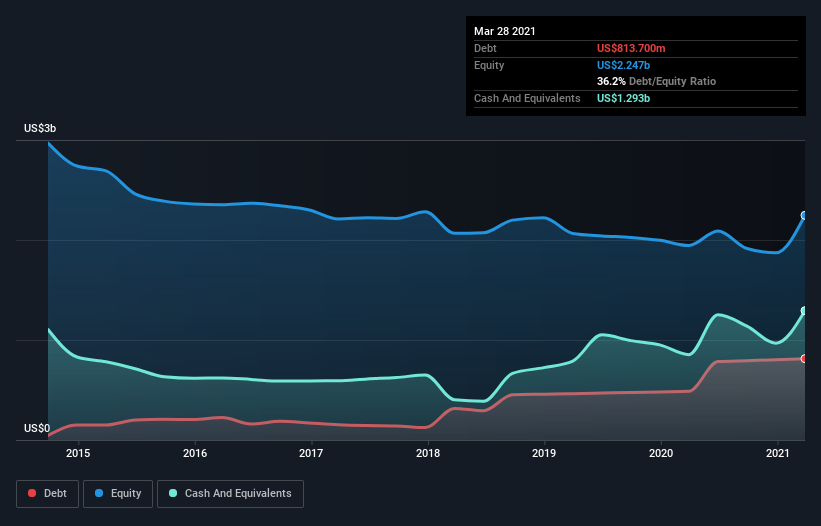Does Cree (NASDAQ:CREE) Have A Healthy Balance Sheet?
Legendary fund manager Li Lu (who Charlie Munger backed) once said, 'The biggest investment risk is not the volatility of prices, but whether you will suffer a permanent loss of capital.' When we think about how risky a company is, we always like to look at its use of debt, since debt overload can lead to ruin. Importantly, Cree, Inc. (NASDAQ:CREE) does carry debt. But should shareholders be worried about its use of debt?
When Is Debt Dangerous?
Debt is a tool to help businesses grow, but if a business is incapable of paying off its lenders, then it exists at their mercy. Part and parcel of capitalism is the process of 'creative destruction' where failed businesses are mercilessly liquidated by their bankers. However, a more usual (but still expensive) situation is where a company must dilute shareholders at a cheap share price simply to get debt under control. Of course, the upside of debt is that it often represents cheap capital, especially when it replaces dilution in a company with the ability to reinvest at high rates of return. The first step when considering a company's debt levels is to consider its cash and debt together.
Check out our latest analysis for Cree
What Is Cree's Net Debt?
The image below, which you can click on for greater detail, shows that at March 2021 Cree had debt of US$813.7m, up from US$486.3m in one year. However, it does have US$1.29b in cash offsetting this, leading to net cash of US$479.6m.
How Strong Is Cree's Balance Sheet?
We can see from the most recent balance sheet that Cree had liabilities of US$382.8m falling due within a year, and liabilities of US$877.9m due beyond that. Offsetting this, it had US$1.29b in cash and US$97.2m in receivables that were due within 12 months. So it actually has US$129.8m more liquid assets than total liabilities.
This state of affairs indicates that Cree's balance sheet looks quite solid, as its total liabilities are just about equal to its liquid assets. So it's very unlikely that the US$10.7b company is short on cash, but still worth keeping an eye on the balance sheet. Simply put, the fact that Cree has more cash than debt is arguably a good indication that it can manage its debt safely. The balance sheet is clearly the area to focus on when you are analysing debt. But ultimately the future profitability of the business will decide if Cree can strengthen its balance sheet over time. So if you're focused on the future you can check out this free report showing analyst profit forecasts.
In the last year Cree wasn't profitable at an EBIT level, but managed to grow its revenue by 50%, to US$921m. With any luck the company will be able to grow its way to profitability.
So How Risky Is Cree?
Statistically speaking companies that lose money are riskier than those that make money. And in the last year Cree had an earnings before interest and tax (EBIT) loss, truth be told. And over the same period it saw negative free cash outflow of US$537m and booked a US$235m accounting loss. But the saving grace is the US$479.6m on the balance sheet. That kitty means the company can keep spending for growth for at least two years, at current rates. Cree's revenue growth shone bright over the last year, so it may well be in a position to turn a profit in due course. Pre-profit companies are often risky, but they can also offer great rewards. When analysing debt levels, the balance sheet is the obvious place to start. But ultimately, every company can contain risks that exist outside of the balance sheet. These risks can be hard to spot. Every company has them, and we've spotted 2 warning signs for Cree you should know about.
At the end of the day, it's often better to focus on companies that are free from net debt. You can access our special list of such companies (all with a track record of profit growth). It's free.
This article by Simply Wall St is general in nature. It does not constitute a recommendation to buy or sell any stock, and does not take account of your objectives, or your financial situation. We aim to bring you long-term focused analysis driven by fundamental data. Note that our analysis may not factor in the latest price-sensitive company announcements or qualitative material. Simply Wall St has no position in any stocks mentioned.
Have feedback on this article? Concerned about the content? Get in touch with us directly. Alternatively, email editorial-team (at) simplywallst.com.

 Yahoo Finance
Yahoo Finance 
